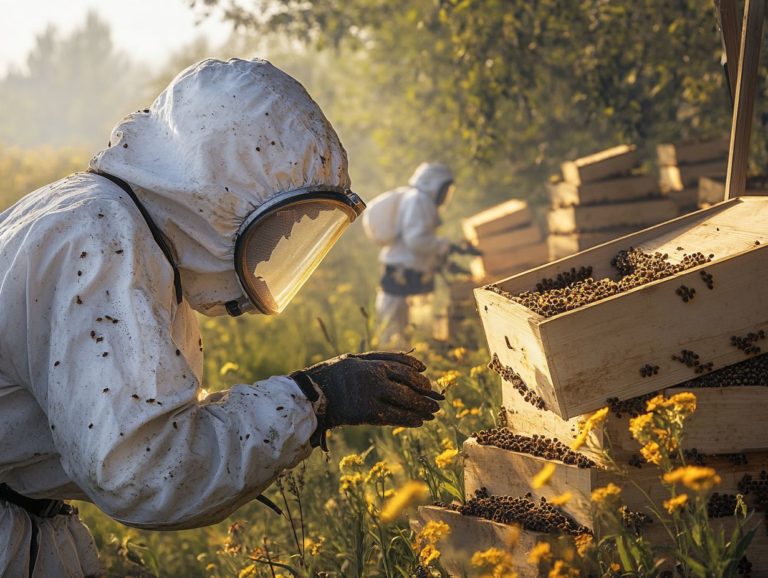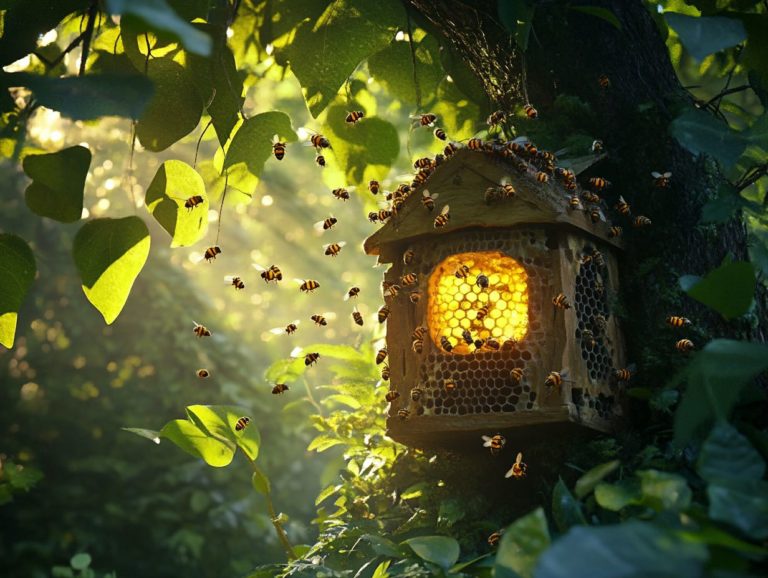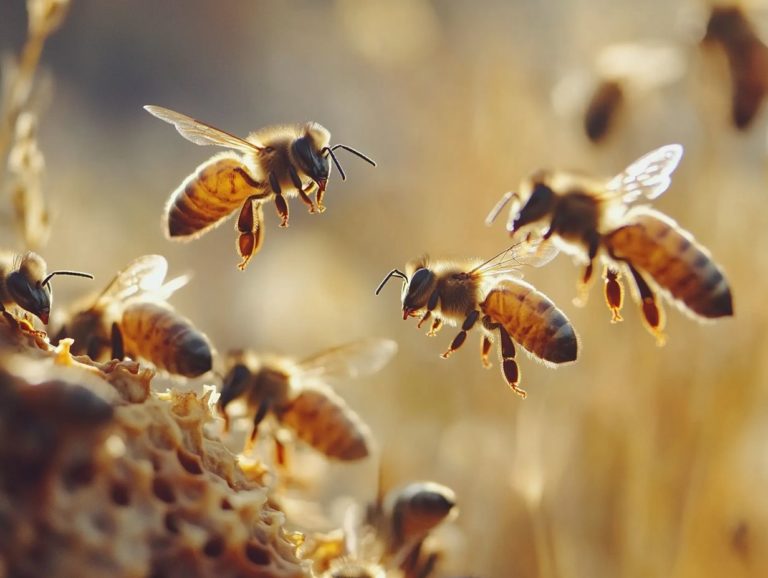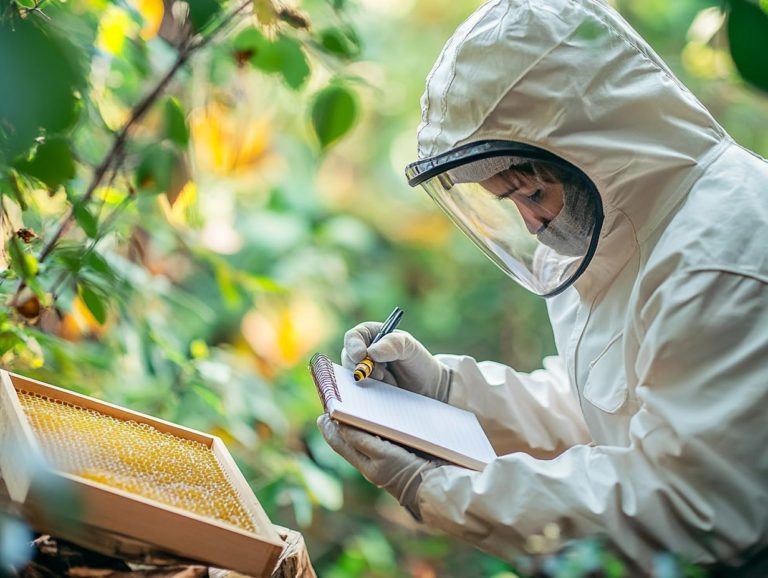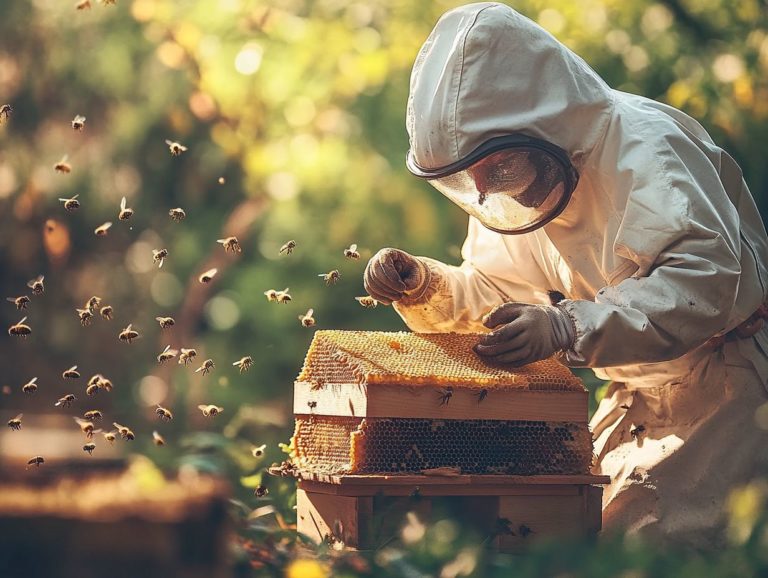Understanding the Role of Worker Bees
Have you ever wondered what makes worker bees so vital to their hives? Worker bees are the unsung heroes of the bee hive, fulfilling crucial roles that extend far beyond the charming buzz they create.
From the intriguing stages of their development to their myriad responsibilities, these diligent insects form the backbone of their honey bee colonies. This exploration highlights the challenges they face, including defending the hive against predators, and delves into the physical characteristics of worker bees, their average lifespan, and the meticulously organized division of labor that sustains the hive s vitality.
Embark on this journey to uncover the extraordinary world of worker bees and appreciate their essential role in the tapestry of nature, from honey production to hive survival.
Contents
Key Takeaways:
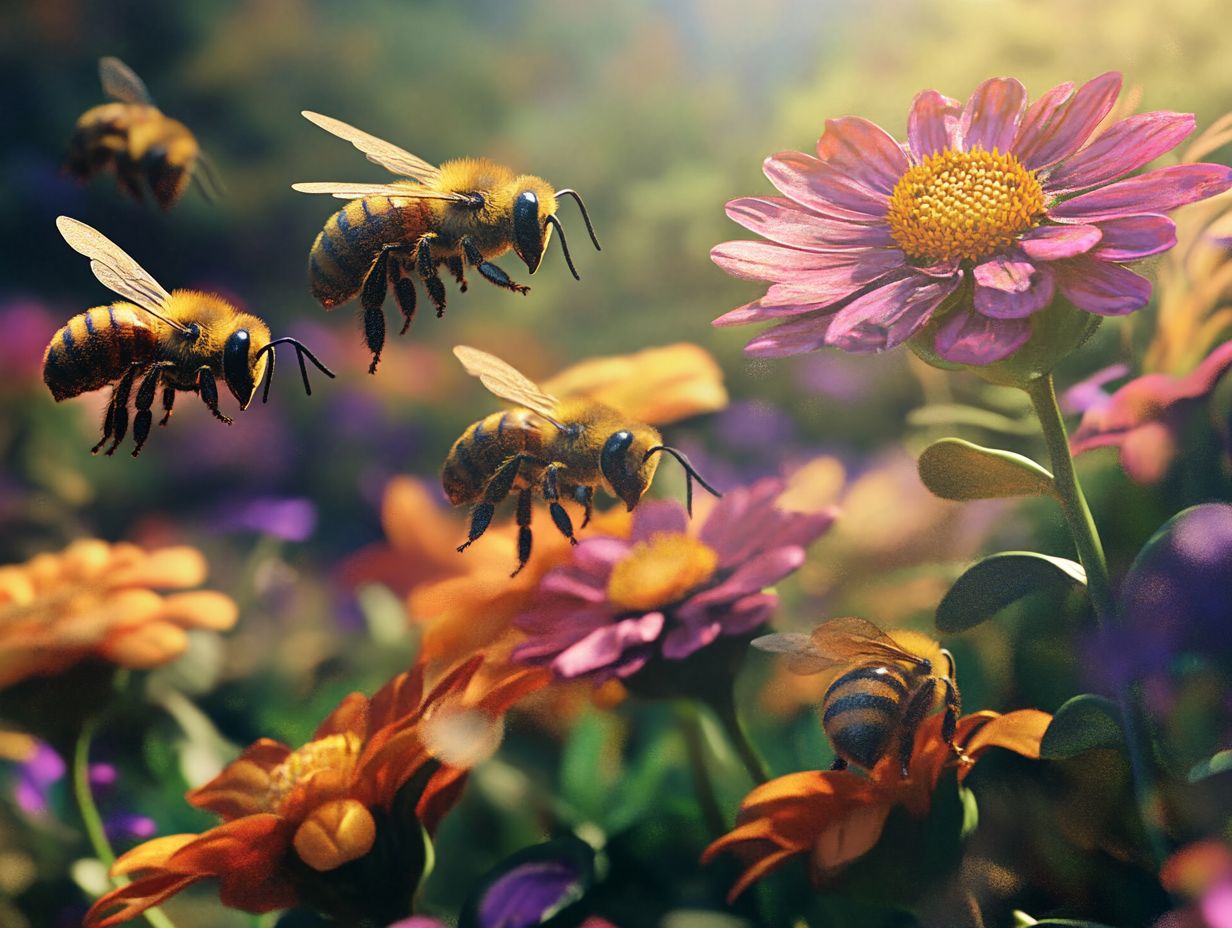
- Worker bees are female bees responsible for various tasks in the hive, such as caring for the queen bee, building and maintaining the hive, and foraging for food and water, including nectar collection.
- Worker bees go through different stages of development from egg to larva to pupa before emerging as adult bees, ready to take on their designated worker duties.
- Worker bees have a lifespan of about 4-6 weeks and are characterized by small, compact bodies and specialized body parts like wax glands and pollen baskets for their duties.
What Are Worker Bees?
Worker bees, the diligent female members of the honey bee colony, are essential to the health and productivity of the hive. Their responsibilities include a variety of tasks that not only support the queen bee but also guarantee the survival of the entire colony.
You ll find these industrious bees foraging for nectar and pollen, nurturing larvae, and regulating the hive’s temperature. This remarkable division of labor underscores their significance in the bee ecosystem.
The well-being of bee populations hinges on these committed workers, as they skillfully utilize hive resources to nourish and safeguard their communities.
What Is Their Role In The Hive?
Worker bees are truly the backbone of the hive, diligently performing essential tasks such as foraging for nectar and pollen, nurturing young larvae, and managing the hive s resources. In addition, they keep the hive clean, ensuring it remains free from debris and harmful pathogens, which ultimately protects the health of the queen and the entire colony.
Some of these industrious bees serve as guards, standing watch at the entrance to the hive to ward off predators and intruders, safeguarding the queen and her precious brood. Beyond their protective duties, they play a pivotal role in honey production, collecting nectar and transforming it into honey, a crucial food source that sustains the colony throughout the year.
Together, these functions work in perfect harmony to support the queen bee, reinforcing the hive s structure and ensuring its overall vitality.
How Do Worker Bees Develop?
The development of worker bees presents a captivating journey that starts with the queen bee laying her eggs in six-sided compartments, which sets in motion a sequence of distinct stages that define their roles within the hive.
Once the queen has deposited her eggs, they hatch into bee larvae, which are lovingly cared for and fed by nursing bees for several days. After this nurturing phase, the larvae enter a transformative stage, undergoing change within the cells.
Ultimately, they mature into adult worker bees, poised to take on their responsibilities, which are dictated by the seasonal shifts and the evolving needs of the colony.
In summary, worker bees are essential to maintaining the hive and supporting the queen. Their tireless efforts not only ensure the success of their colony but also play a critical role in our environment. Appreciate their contributions and the vital importance of saving their habitats.
What Are The Different Stages Of Development?
The fascinating journey of worker bee development encompasses several vital stages: the egg stage, larval stage, and pupal stage. Each stage plays an essential role in the honey bee life cycle, crucial for colony needs and hive roles.
During the egg stage, which lasts around three days, the queen carefully lays fertilized eggs in individual cells of the honeycomb. It s imperative that conditions within the hive are optimal for these eggs to thrive. Once they hatch, the larvae enter a feeding stage that spans approximately six days. Here, they feast on a powerful diet of pollen and honey, called “bee bread.” This powerful diet is key to their growth and health! Keep in mind that environmental factors like temperature and humidity significantly influence the maturation of these larvae.
After the larval stage comes the transformative pupal stage, where the bees cocoon themselves and undergo metamorphosis the process of changing from a larva into a fully-formed bee over the next ten days. It is in this stage that they prepare to emerge as adult bees, ready to contribute to the hive’s intricate ecosystem.
What Are The Physical Characteristics Of Worker Bees?
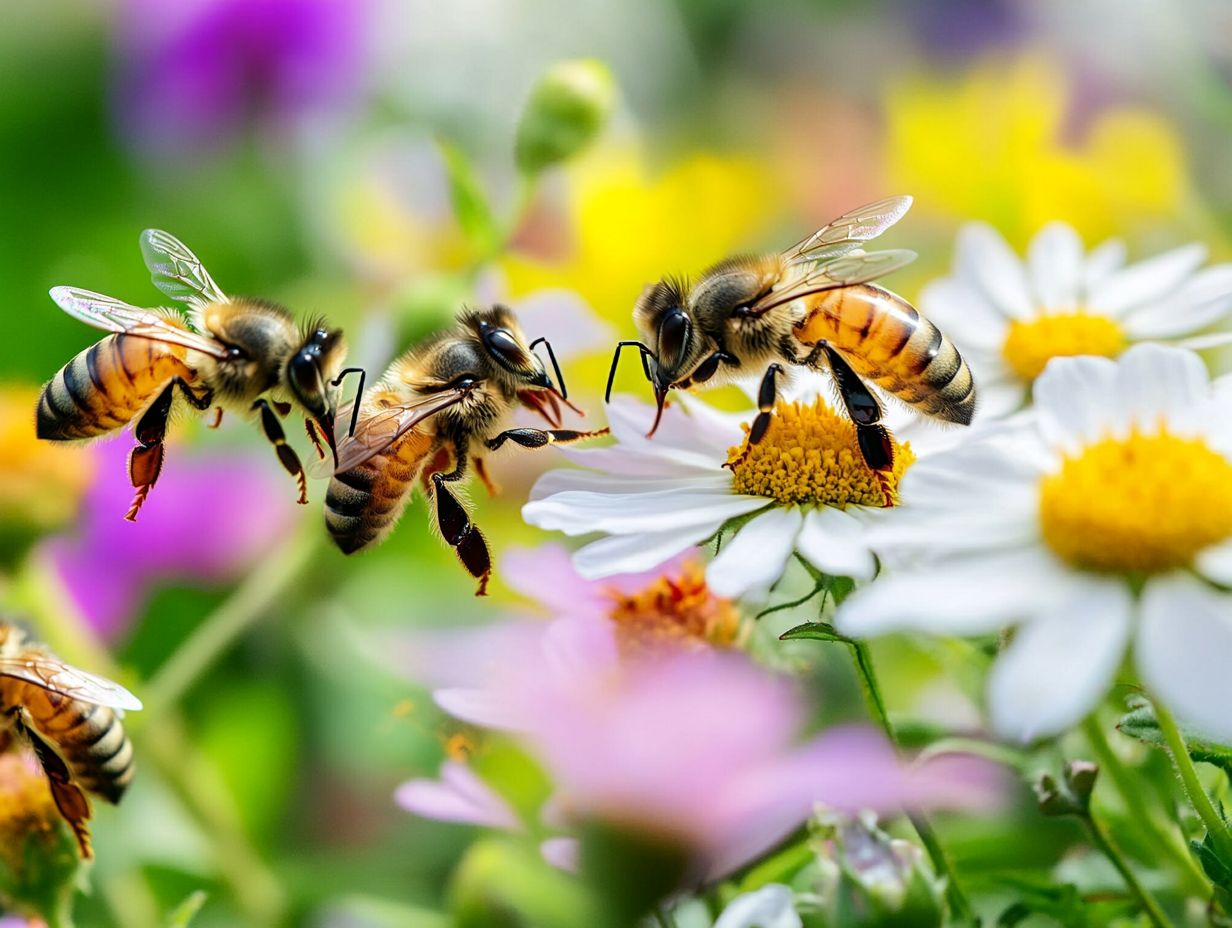
Worker bees are truly amazing! Their unique physical traits help them perform essential tasks with incredible efficiency. With their specialized anatomy, they boast pollen baskets on their hind legs for seamless nectar collection and wax glands that facilitate the construction of the comb.
Moreover, the bee stinger is a noteworthy feature, serving as an essential instrument for defending the hive against potential predators. These adaptations not only enhance their foraging prowess but also play a significant role in ensuring the survival and productivity of the entire honey bee colony.
What Is The Average Lifespan Of A Worker Bee?
The average lifespan of a worker bee can vary quite a bit, influenced by numerous factors, especially seasonal changes. Summer bees typically live around six weeks, while their winter counterparts can survive for several months.
Several elements interact to determine the longevity of these crucial pollinators. Environmental conditions, such as temperature and the availability of food sources, play a vital role in their survival. During the warm months, for example, the hive buzzes with energy and activity. Summer bees expend significant energy foraging and maintaining the hive, which ultimately shortens their lives. Beekeepers often monitor these activities through regular bee inspections.
On the flip side, winter bees, born toward the end of summer and early fall, take on a more insulating role, contributing to the warmth and stability of the colony. Their slower-paced lifestyle, combined with the support they receive from the collective efforts of the hive during the colder months, allows them to enjoy longer lifespans.
The overall health of the colony also affects the lifespan of a worker bee, including factors like disease pressures and hive dynamics, which can significantly impact how long a worker bee can thrive.
What Are The Duties Of Worker Bees?
As you delve into the fascinating world of bees, you’ll find that worker bees are vital for keeping the hive running smoothly. Their responsibilities span a remarkable range of tasks, including foraging for nectar and pollen, nurturing young larvae, cleaning the hive, and managing its resources.
Each worker bee takes on specific roles determined by their age and the unique needs of the colony. This intricate level of organization and cooperation, facilitated by pheromone communication, highlights the extraordinary efforts that ensure the health and productivity of the entire bee population. Understanding their roles is vital for protecting our ecosystems!
What Are The Different Types Of Worker Bees?
You ll find that there are several types of worker bees, each with its own specialized role that caters to the hive’s needs. Foraging bees are the brave adventurers of the colony, venturing out to gather nectar and pollen essential food sources for their community.
House bees manage life within the hive. They handle duties like cleaning the cells, caring for the queen, and maintaining the hive s temperature to ensure a comfortable environment.
Nursing bees are nurturing caretakers dedicated to their brood. They feed the larvae royal jelly, pollen, and honey, ensuring these young bees grow into healthy adults.
Then there are the fat bees, which play a crucial role by storing energy reserves. These reserves become invaluable during times of scarcity, helping to cushion the hive against shortages.
This remarkable division of labor among the different types of worker bees enhances the hive’s overall productivity and survival, showcasing nature’s intricate design at its finest. From nursing bees to foraging bees, all contribute essential roles to the hive.
What Is The Division Of Labor Among Worker Bees?
The division of labor among worker bees unfolds as a well-organized system that enables the hive to operate seamlessly. Tasks are meticulously allocated based on age and necessity.
This intricate arrangement is crucial for the colony’s survival, as each bee plays a vital role in various aspects of hive maintenance and productivity. In their early days, the younger bees, often known as house bees, take on essential responsibilities such as cleaning the cells, caring for the queen, and feeding the larvae.
As they mature, these bees transition into foragers, stepping outside the hive to gather nectar and pollen.
This shift not only signals their physical growth but also guarantees that the colony remains well-fed with a steady supply of food. The harmony of this age-based division of labor significantly boosts hive efficiency, enabling the community to flourish despite environmental challenges.
What Are The Threats To Worker Bees?

Worker bees encounter a myriad of threats that can profoundly affect their health and the sustainability of the entire hive. From predators lurking in the shadows to the harmful repercussions of pesticides on bee populations, these challenges pose significant risks to the honey bees and the queen bee.
The fate of every worker bee impacts the entire colony’s survival! Therefore, it becomes essential for you to grasp and tackle these pressing issues to safeguard the delicate ecosystems and hive resources that bees inhabit.
What Are The Common Pests That Attack Worker Bees?
Common pests that target worker bees, such as varroa mites and small hive beetles, pose significant threats to the health and productivity of your hives.
These pests induce stress within bee colonies, leading to decreased populations and weakened hive dynamics. Varroa mites attach themselves to bees, feeding on their bodily fluids, which ultimately results in malnourished and weakened workers.
Similarly, small hive beetles can disrupt the delicate balance of a hive by scavenging stored honey and even forcing the destruction of brood and bee larvae. This not only reduces the workforce available for foraging and maintaining the hive but also invites diseases that can swiftly decimate a colony.
To tackle these challenges, you should implement regular monitoring of pest levels, maintain cleanliness within the hive, and adopt integrated pest management strategies. Consider introducing natural predators or utilizing essential oils to safeguard your valuable pollinators and ensure the resilience of your hives.
Regular bee inspections can also help you identify and address pest problems early on.
Join the movement to protect bees and ensure their safe environment!
How Do Pesticides Affect Worker Bees?
Pesticides significantly impact worker bees. These chemicals lead to declines in hive health and bee populations, disrupting our ecosystem’s delicate balance.
They interfere with how bees search for food. This can hinder their ability to find and collect essential resources.
Exposure to pesticides also harms their reproductive health, reducing the production of baby bees and weakening colonies. This compromised health makes worker bees more vulnerable to sicknesses and harmful bugs, intensifying the decline in their population.
Pesticides can also harm their wax glands and pollen baskets, which are crucial for their roles in the hive.
The impact on our environment is huge! Bees are critical for pollinating crops and wild plants, and without them, we could face food shortages and loss of biodiversity.
To protect worker bees, we must adopt integrated pest management strategies, promote organic farming, and enhance habitat diversity. These steps will help ensure that worker bee populations not only survive but thrive.
What Is The Importance of Worker Bees to the Ecosystem?
Worker bees are vital for maintaining our ecosystem. Their contributions to pollination and honey production support biodiversity.
By pollinating countless plant species, they help sustain their colonies and ensure food sources and habitats for many organisms.
These diligent insects directly influence agricultural productivity and overall ecosystem health. Organizations like the American Honey Tasting Society have highlighted the significance of honey bees in our food systems.
How Do They Contribute to Pollination?
Worker bees play an essential role in pollination. They tirelessly search for nectar and pollen, which supports flowering plants’ reproduction.
This foraging behavior not only benefits the bees but is crucial for biodiversity and ecosystem health. Their nectar collection also supports honey production, vital for hive survival and for us!
As you observe these industrious pollinators, notice how they transfer pollen between flowers. This process facilitates fertilization, leading to the production of fruits and seeds.
In farming, the activities of worker bees significantly boost crop yields. They are especially important for fruits, nuts, and vegetables that rely on cross-pollination.
Their presence ensures the stability of both wild flora and cultivated landscapes. This highlights the interconnectedness of bee health and environmental sustainability.
Beekeepers depend on worker bees to maintain healthy hives and support agricultural productivity.
What Other Roles Do They Play In The Environment?

Beyond pollination, worker bees fulfill vital roles in the environment, including honey production and supporting biodiversity. They also participate in comb building and hive maintenance, which are essential for the hive’s structure and survival.
These industrious insects are crucial not only for fertilizing flowering plants but also for acting as keystones in food webs, creating many benefits for the environment. By aiding in the growth of diverse crops and wild flora, they enhance food security and bolster ecosystem resilience.
The honey they produce offers a sweet indulgence for humans and a vital source of nutrition for wildlife, making their role crucial in our diets. Various honey recipes have been developed to make use of this natural sweetener.
The byproducts of honey, such as beeswax and propolis, support various industries, creating a symbiotic relationship between bees and human society. Their presence fosters healthy ecosystems, ultimately sustaining life on our planet. Books like Beekeeping For Dummies provide insights into the importance of these industrious insects and offer practical advice for aspiring beekeepers.
Frequently Asked Questions
What is the role of worker bees in a beehive?
The primary role of worker bees is to maintain the overall functioning of the beehive. Their tasks include collecting nectar, pollinating flowers, and caring for the queen and her young. They also perform essential duties such as nursing young, cleaning, guarding the hive, and temperature regulation within the hive.
How long do worker bees typically live?
Worker bees have a relatively short lifespan of about 4-6 weeks during the peak season. However, winter worker bees can live up to 4-6 months as they help keep the hive warm and protected during colder months. This distinction between summer bees and winter bees is crucial for the hive’s seasonal adaptability and winter cluster formation.
Do all worker bees perform the same tasks?
No, worker bees have distinct roles based on their age. Younger workers are responsible for tasks inside the hive, such as tending to the bee brood and cleaning, while older ones handle outdoor tasks like foraging for food and guarding the hive.
What happens if a worker bee dies?
If a worker bee dies, the rest of the workers will quickly replace it with a new one. This ensures that the hive’s tasks and overall functioning are not disrupted.
How do worker bees communicate with each other?
Worker bees communicate through a series of complex dances and pheromones, which are chemical signals that convey important information, such as the location of food sources and potential threats to the hive.
Can worker bees sting?
Yes, worker bees are capable of stinging, but they will only do so as a last resort to protect the hive. Male bees, also known as drones, do not have stingers and do not participate in the hive’s tasks. Understanding the function of the bee stinger is important for beekeepers, especially when dealing with hive defense.
Interested in supporting local bee populations? Consider starting your own garden to attract these essential creatures!


